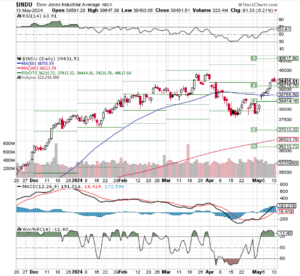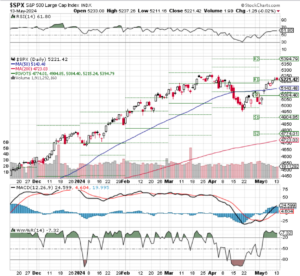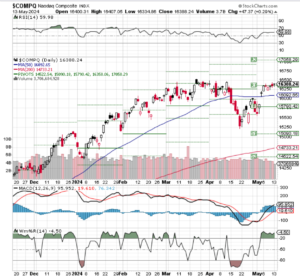HI Market View Commentary 05-13-2024
First – Over the last week with META moving higher I have had a on of calls:
Some were next steps, some were let’s get in, some were what are we doing?
Most people panic on the bearish opportunity for stocks = time value or time line to make mone
Most people want to get in on the bullish reward side = missed the bottom and sometimes the opportunity
It is impossible to time the market accurately
For those who asked what are we doing now – We already have bull call/stock replace strategies in place
Should we take the profit on the short 600 call side?
Trade Findings and Adjustments 05-09-2024 – META Adjustments to Leap Bull Calls
Earnings Season:
BABA 05/14 BMO
BIDU 05/16 BMO
DG 05/30
MU 06/26
TGT 05/22 BMO
UAA 05/16 BMO
https://www.briefing.com/the-big-picture
The Big Picture
Last Updated: 10-May-24 15:35 ET | Archive
So much easy money
Saving money can be easier said than done. There are a lot of uses for one’s money. Some (like vacations) are fun, some (like hospital bills) are not, and others (like food) are essential.
Some people have plenty of disposable income, making it easier for them to save. Others live paycheck-to-paycheck, making it nearly impossible to set aside cash in a reserve fund. The general rule of thumb espoused by financial planners is that one should aim to save three to six months’ worth of living expenses in an emergency fund.
Ideally, that fund will be earning some interest on that idle cash and not losing purchasing power stashed in a coffee can or under a mattress.
Of course, it wasn’t that long ago when cash was losing purchasing power even if it was kept in an interest-bearing account. That’s when the Fed was holding its policy rate at the zero bound and when many financial institutions were keeping depositors’ savings rates near the zero bound as well. That started to change in March 2022 when the Fed began raising rates to fight back in an inflation battle it had been losing badly.
There have been 11 rate hikes during the Fed’s tightening campaign. Those rate hikes have helped it score some wins in the inflation battle, but it has not yet won the war. In any case, those rate hikes have been instrumental in driving up deposit rates, CD rates, bond rates, and interest rates in general, which includes rates on revolving and non-revolving credit.
The higher rates aren’t all good, then, but they have been indisputably good for savers who had been fighting a losing battle on the interest rate front since the financial crisis.
It is little wonder, then, that savers are seeking yield and finding it in many places that are providing some real returns for their emergency and non-emergency funds. In one sense, that makes the stock market’s run to new record highs all the more remarkable. In another sense, it offers a nice cushion of latent support for the stock market if/when rates come down.
Easy Money
The numbers are stunning.
Total money market fund mutual fund assets stand at $6.03 trillion with $2.42 trillion in retail funds and $3.61 trillion in institutional funds, according to the Investment Company Institute. That is up from $3.63 trillion, $1.37 trillion, and $2.26 trillion, respectively, just before the Covid storm and the fiscal/monetary policy stimulus that rained down on the U.S. in its wake.
The chart above shows the ramp in money market mutual fund assets that started when the Fed started its rate hikes in 2022, moving the target range for the fed funds rate from 0.00-0.25% to its current level of 5.25-5.50%.
Money market mutual funds invest in highly liquid and short-term securities like Treasury bills, commercial paper, and certificates of deposit, which is to say lower-risk securities.
The yield on money market mutual funds just before Covid struck was less than 0.50%. Nowadays, you can find 7-day SEC yields (an estimate of the annualized yield based on the income generated by the fund over the previous seven days) north of 5.00% on money market mutual funds.
With the Consumer Price Index up 3.5% over the last 12 months, that is an attractive, relatively risk-free rate that affords a real return for savers not wanting to deploy capital (or as much capital) in the higher-risk stock market.
It is tantamount to “easy money,” whereby the cash works for you. Of course, it is also “idle money” with little productive capacity to drive increased economic growth. In brief, higher rates are good for savers, but less so for the economy.
What It All Means
The stock market has been cheered of late by the idea that the Fed is unlikely to raise rates again. That is understandable because the stock market often loses out (but doesn’t necessarily lose) when rates go up, as future cash flows become worth less and capital finds its way to lower-risk alternatives.
At the moment, savers and investors in the stock market are both winning with the jump in interest rates, which have accompanied stronger-than-expected growth (good for corporate earnings) and sticky inflation. To wit: the S&P 500 and Nasdaq are within a whisker of their record highs reached earlier this year and a relatively risk-free 5.00% yield provides a real return.
What happens, then, when interest rates go down? A lot depends on why interest rates are going down, but in general lower rates bode well for the stock market and not as much for savers trying to stay ahead of inflation.
Some people, though, are working to ensure they can get a return of their capital as opposed to a return on their capital. Those people are in wealth preservation mode, either because they have made a ton of money already and don’t want to lose it, or perhaps because they are on a fixed budget and are content earning a lower real rate of return so long as they don’t lose money or purchasing power. There are myriad reasons why. These are just two simple explanations.
The real return on money market mutual funds isn’t exactly a showstopper. Let’s call it approximately 1.5% versus approximately 6.0% for the S&P 500. Which is the better investment? The answer seems clear, but it really isn’t, because risk tolerances and objectives need to be taken into account.
The key takeaway, though, is that savers have a savings option now that they were largely robbed of between 2007 and 2022. Given that, they are unlikely to be cheering the prospect of lower rates like the stock market is, because they will be forced to take on more risk to outrun inflation.
That will presumably be a good trade-off for the stock market, which will be a beneficiary of asset flows away from lower-yielding investments.
—Patrick J. O’Hare, Briefing.com
Earnings dates:
Where will our markets end this week?
Lower
DJIA – Bullish
SPX – Bullish
COMP – Bullish
Where Will the SPX end May 2024?
05-13-2024 -2.0%
05-06-2024 -2.0%
04-29-2024 -2.0%
Earnings:
Mon:
Tues: HD, BABA
Wed: CSCO,
Thur: DE, WMT, BIDU, UAA
Fri:
Econ Reports:
Mon:
Tue PPI, Core PPI
Wed: MBA, CPI, Core CPI, HAHB Housing Price Index, Retail Sales, Retail ex-trans, Business Inventories,
Thur: Initial Claims, Continuing Claims, Housing Starts, Building Permits, Import, Export, Capacity Utilization, Industrial Production,
Fri: Leading Indicators,
How am I looking to trade?
Mostly letting stocks run = very little protection in place – GOOGL $170, DIS $114, BIDU $110
www.myhurleyinvestment.com = Blogsite
info@hurleyinvestments.com = Email
Questions???
Here’s where to invest $1 million right now, according to the pros
PUBLISHED SUN, MAR 24 20247:20 PM EDTUPDATED WED, MAY 1 202410:10 AM EDT
Colin Anderson Productions Pty Ltd | Digitalvision | Getty Images
Markets are red-hot, and investors might be wondering what they can buy right now.
The S&P 500 reached a record high in March despite corners of it already getting expensive, some pros believe. There could be more uncertainty, with some still expecting the U.S. Federal Reserve not to cut rates despite the central bank indicating it’s staying on track for three rate cuts this year.
On top of that, some are calling for investors to move out of cash if rates do fall.
If you had a spare $1 million to invest right now, what should you buy?
CNBC Pro asked fund managers and wealth advisors how they would allocate their portfolios with that money.
The 60/40 portfolio
The 60/40 portfolio is a good starting point for many investors. Indeed, Aaron Benson, portfolio manager at investment bank Baird, says he uses the strategy for many of his clients’ portfolios.
He would allocate roughly 60% into stocks this way: 15% each to U.S. large-cap growth stocks and U.S. large-cap value stocks; 4% to small-caps; and 8% to mid-caps. Another 15% would go to international developed as well as emerging markets equities.
“We really believe in style diversification and feel that remaining diversified with value and growth stocks remains prudent,” Benson said.
He stressed that because the small-cap market is “less efficient,” it’s more important to do active stock-picking and identify the best opportunities.
“Small cap stocks based on price-to-earnings ratio are the cheapest they’ve been since really the tech bubble, relative to large-caps,” he said. “We see that more as a long-term opportunity.”
With a million dollars to invest, it would be “reasonable” for investors to put their money in both small- and mid-cap stocks now, he said.
Benson added that global stocks look “very cheap” right now, relative to their U.S. peers. “So we feel very comfortable including that as a portion of one’s allocation with with new capital to invest.”
As for fixed income, Benson would allocate about 40% this way: 10% to short-term taxable fixed income; 25% to intermediate-term fixed income; and 3% to high-yield bonds.
A final 5% would go toward real assets, which are “good diversifiers’ to stocks and bonds, he said. Examples he cited are real estate, infrastructure and commodities.
Baird’s assets under management stand at more than $405 billion, while its private wealth management assets under management are over $275 billion. The size of the average client account is about $1.2 million.
Chris Fasciano, senior portfolio manager at Commonwealth Financial Network, also believes that the 60/40 portfolio is “again a worthwhile asset allocation.”
For the 60% allocated to stocks, he would focus on U.S. large-cap growth, value, small- and mid-cap stocks, as well as international equities. As for bonds, he likes intermediate-term fixed income.
AI’s power needs, tech and health care
If you’re an investor interested in focusing on tech and artificial intelligence, take a look at the allocation of Shams Afzal, managing director at Carnegie Investment Counsel.
A good chunk of his model portfolio comprises allocations to tech and growth stocks, industrials such as power plays on AI, and semiconductors.
“As AI went mainstream in 2023, it sent capital spending in cloud computing capacity and data center storage into overdrive. Valuations in the sector leave little room for error and multi-year growth is almost a foregone conclusion in semiconductors, data centers and other verticals,” Afzal said.
“This was clear in Nvidia’s recent earnings that showed 400% growth year over year in their data center business alone,” he said.
As a result, he said, there is “urgency for grid modernization and future-proofing” of power needs driven by hyperscale computing. Afzal named one stock to play on AI’s power needs: Watsco.
Overall, these are his allocations, as he named exchange-traded funds as a way to invest in such trends and more. This portfolio is for a timeframe of one year or so.
A GROWTH- AND TECH-FOCUSED MODEL PORTFOLIO
| TYPE OF ASSET | ETF/HOW TO INVEST IN THE THEME | ALLOCATION |
| GROWTH STOCKS | US SPDR S&P 500 Growth (SPYG) | 12% |
| TECH STOCKS | US SPDR Tech Sector (XLK) | 26% |
| SEMICONDUCTOR STOCKS | VanEck Semiconductor (SMH) | 5% |
| ELECTRIFICATION AND RESIDENTIAL ENERGY SYSTEMS UPGRADE CYCLE PLAYS | Stocks like Eaton, Watsco. US SPDR Industrials ETF (XLI) | 8% |
| US HEALTHCARE | Medical devices stocks such as Stryker and Abbott Labs Health Care Select Sector SPDR Fund (XLV) | 10% |
| US FINANCIALS | Financial Select Sector SPDR Fund (XLF) | 9% |
| US ENERGY | Energy Select Sector SPDR Fund (XLE) | 5% |
| MEXICO STOCKS | iShares MSCI Mexico ETF (EWW) | 10% |
| INDIAN STOCKS | Franklin FTSE India ETF (FLIN) | 5% |
| US TREASURIES: 1 YR OR SHORTER IN MATURITY | – | 10% |
Source: Shams Afzal of Carnegie Investment Counsel
When it comes to international stocks, Afzal likes Mexico as it’s a direct beneficiary of China’s dwindling foreign direct investments. He added that he’s bullish on India for three reasons: It “remains the go-to destination” for sourcing high-tech labor; is undergoing a digital transformation across industries; and is seeing “healthy” demand from its “sizeable” middle class.
100% to stocks for the ‘moderately aggressive’
Louis Navellier, chairman and founder of Navellier & Associates, would be 100% invested in stocks.
He has a portfolio for the “moderately aggressive” investor, although he says much of the risk comes from small-cap stocks.
Overall, he said, “The U.S. is somewhat of an oasis now, because obviously China looks like they’ve got a real problem.”
While buying bonds could be a good idea now as yields are set to fall, U.S. investors get taxed more on bonds than on stocks, Navellier said.
“I would rather have long term capital gains, which is taxed at a 20% rate, then bond interest tax at a 37% rate,” he added.
This is a breakdown of the top 15 holdings in his portfolio.
TOP HOLDINGS OF A STOCK PORTFOLIO FOR THE ‘MODERATELY AGGRESSIVE’
| STOCK | ALLOCATION |
| NVIDIA | 11.88% |
| SUPER MICRO COMPUTER | 4.94% |
| ELI LILLY & CO | 4.12% |
| NOVO NORDISK | 3.96% |
| EMCOR GROUP | 3.07% |
| TOLL BROTHERS | 2.74% |
| EOG RESOURCES | 2.74% |
| QUANTA SERVICES | 2.65% |
| EXXON MOBIL | 2.59% |
| VISTA ENERGY | 2.57% |
| PACCAR | 2.49% |
| CONOCOPHILLIPS | 2.25% |
| CROWDSTRIKE | 2.22% |
| MICROSOFT | 2.18% |
| SPOTIFY TECHNOLOGY | 2.15% |
Source: Louis Navellier of Navellier & Associates
He’s very bullish on Nvidia and Super Micro Computer right now, saying their earnings are “growing fast” and Nvidia is still dominating the chips space. Here’s why he’s positive on Nvidia and Super Micro Computer.
Navellier also has other global stocks in his portfolio, including Chinese electric vehicle maker Li Auto, Mexico’s Vista Energy, German automaker Volkswagen and Canadian gold producer Alamos Gold.
The average amount of money that his clients invest is $1.3 million, and his firm manages over $1.2 billion.
NBA Champion Dwyane Wade says it took years to learn how to manage his millions: ‘I had never really handled more than $500 at a time’
Published Sat, May 11 20249:00 AM EDTUpdated Mon, May 13 20249:22 AM EDT
With three NBA championships and close to $200 million in career earnings to his name, Dwyane Wade knows a thing or two about being a successful professional athlete.
But the 13-time All-Star says it took him years to feel like he knew what he was doing when it came to his finances. Now, as he pursues a number of post-retirement ventures, Wade sees up-and-coming stars like Caitlin Clark earning millions and hopes they get off to a better start than he did.
“It’s really amazing that they’re having access to this money so young, but you’re also kind of fearful not knowing who they have around them that know about money,” says Wade, who spoke to CNBC Make It while promoting a partnership with Google Workspace.
It’s a sense of protectiveness that comes from experience. Wade, who was drafted by the Miami Heat when he was 21, says that it took him more than half a decade in the NBA “to even start to understand” how to manage his millions.
“I came into the league as someone who had never really handled more than $500 at a time, and [suddenly] I’m making millions of dollars,” Wade says. Knowing who to take money advice from was difficult when he himself knew “nothing at all” about the subject.
I came into the league as someone who had never really handled more than $500 at a time, and [suddenly] I’m making millions of dollars.
Dwyane Wade
NBA CHAMPION
“It’s not that I didn’t have good people around me,” he says. “It’s that no one was making the level of money that I was making. To be able to know what to do, you have to be with people who are on the level that you’re on. And I didn’t do that.”
The 42-year-old tells Make It he hopes the latest crop of newly-minted millionaire basketball players make a concerted effort to educate themselves right at the start.
“You have to find someone that you trust and admire that does well with their money,” he says. “You are capable, because of your status and where you are, to be able to reach out to those individuals. Get a call with them. Ask them how and what to do with your money and how to spend your money and how to think about the money that you have.”
Wade says one of the biggest mistakes he made early on in his career was being too proud to ask for help. And even when he did get financial advice, he was so unfamiliar with the financial basics that “I don’t know if I even understood how to listen.”
He added that it can be difficult to ask for help and admit that you’re uneducated about a certain topic.
“You don’t want people to think less of you because you don’t know something like how much money you have or what to do with your money,” he says.
Ultimately, Wade hopes that the leagues employing the stars of tomorrow make a concerted effort to make sure their players are armed with the information necessary to make smart financial decisions for themselves.
“We talk about wanting athletes to have the opportunity to have generational wealth,” he says. “This is where it starts.”
Inflation is slowing. Here’s why prices still aren’t going down
PUBLISHED SUN, MAY 12 20246:02 AM EDTUPDATED SUN, MAY 12 202412:04 PM EDT
Charlotte Morabito@IN/CHARLOTTEMORABITO/
KEY POINTS
- Historical data suggests a key factor in bringing down prices is a slowdown in consumer spending.
- Despite nearly half of Americans reporting they’re in a worse financial situation than five years ago, they’re still spending.
- Retail sales were up 2.1% year over year in the first quarter of 2024 and consumer spending jumped in February and March.
Jenn Lueke, 27, is a recipe developer based in Boston who creates content online showing people how to eat well on a budget.
“I think it’s no secret that prices are going up in pretty much every area right now,” Lueke told CNBC.
About two thirds, 65%, of U.S. adults surveyed by CNBC/SurveyMonkey this spring said inflation is the main driver of their financial stress. The same share said they are living paycheck to paycheck. Nearly half feel like they’re in a worse financial situation than five years ago.
In January last year, Lueke started a series on social media where she took one grocery list between $50 and $75 and turned it into five different recipes for their families. She was inspired to show people they can still eat well while cutting down on grocery costs.
“It’s really hard. I’m not here to, like, share toxic positivity about how to shop on a budget,” Lueke said. “I’m just trying to empower people to feel like they can get a little bit of control, at least in this one area of their food costs.”
Disinflation, deflation and the ‘money illusion’
“I think Americans are a little perplexed when they see news reports of inflation coming down, and yet they don’t notice any of their prices coming down,” said Lindsay Owens, executive director of the nonprofit think tank Groundwork Collaborative.
There’s an important difference between inflation increasing more slowly — a phenomenon called disinflation — and inflation reversing itself, which would lead to prices coming down. Economists call the latter deflation, which is typically associated with a shrinking economy and potential recessions.
Historical data shows that prices rise a lot easier than they fall. When they do fall, it is typically a result of people spending less, which isn’t currently the case. Retail sales were up 2.1% year over year in the first quarter of this year and consumer spending jumped in February and March.
“This cycle is a concept called money illusion,” said Sabrina Romanoff, a clinical psychologist.
“People with money illusion … don’t take into account the level of inflation in an economy,” she said. “So they wrongly believe that a dollar today is worth the same amount that it was the year prior.”
Experts have raised concern about possible “pockets of trouble” as total credit card balances in the U.S. spiked to a record high of $1.08 trillion in the third quarter of 2023. Nearly half, 49%, of Americans with credit cards say they are carrying a balance from month to month, according to a November 2023 survey by Bankrate.
Wage-increase data may also seem inconsistent with consumer experience. Wages have been rising since January 2022, but the pace of the increase has been slowing down and, on average, it is just keeping up with rising prices. An analysis from Bankrate estimates the gap between inflation and wages won’t fully close until the fourth quarter of 2024.
“For many Americans, wage growth is very overdue,” Owens said. “They have gone years, if not decades in some cases, with stagnant wages or small raises.”




HI Financial Services Mid-Week 06-24-2014